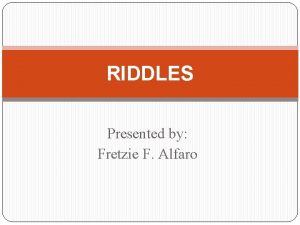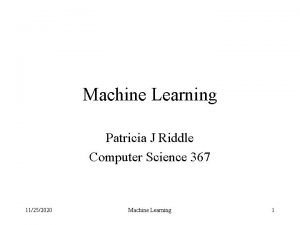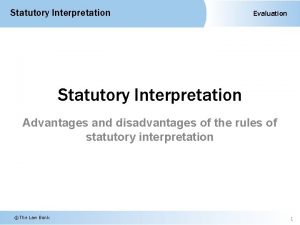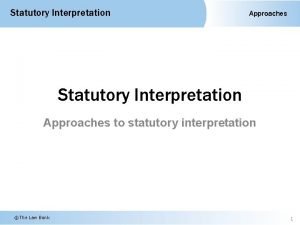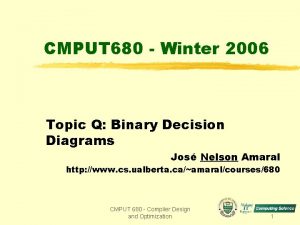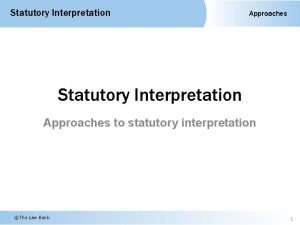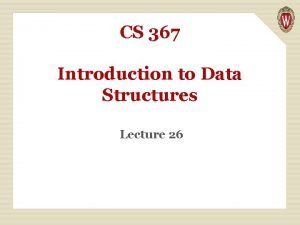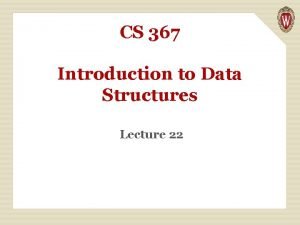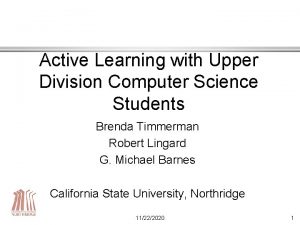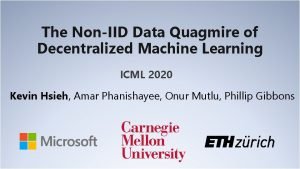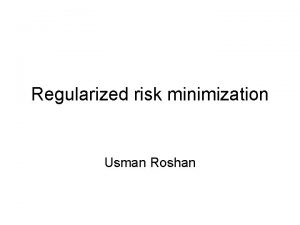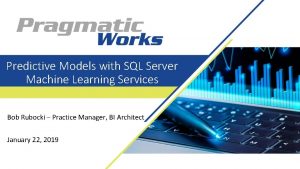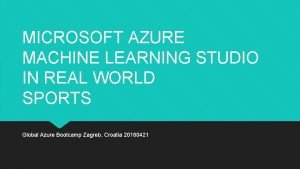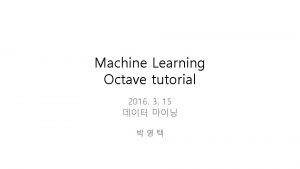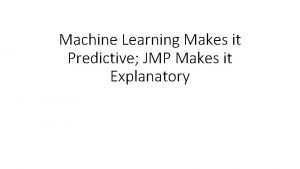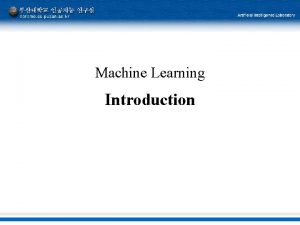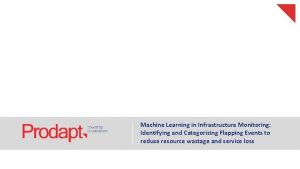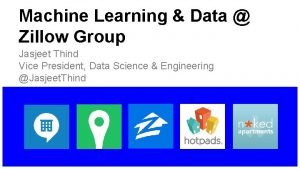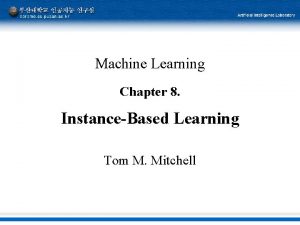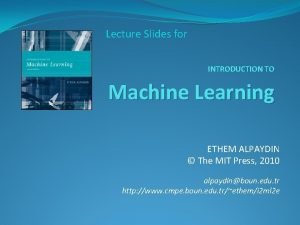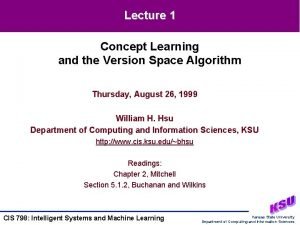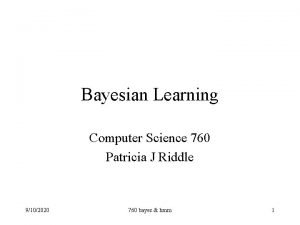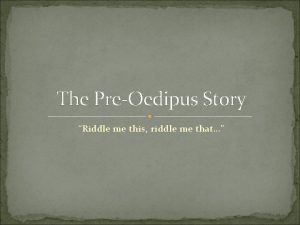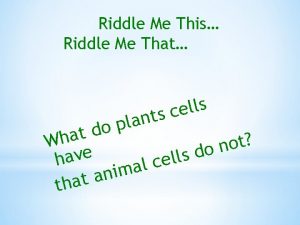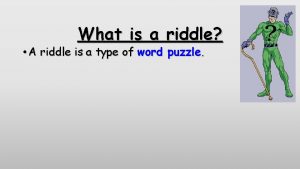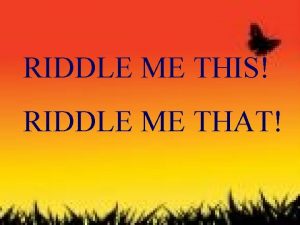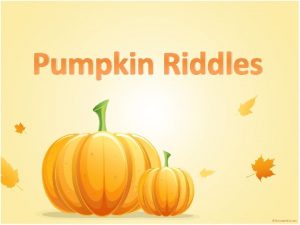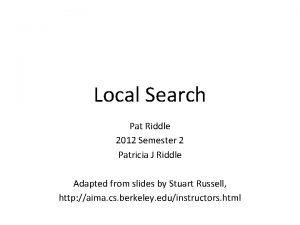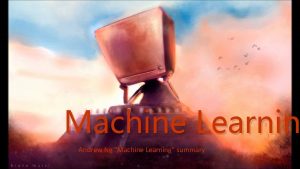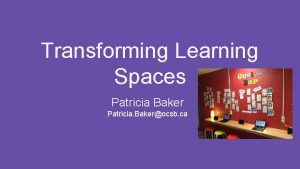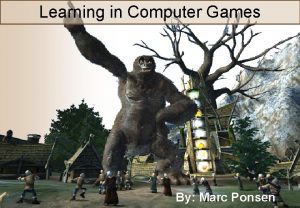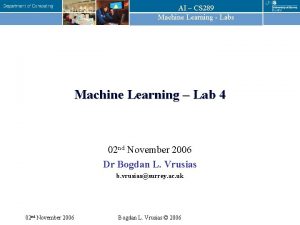Machine Learning Patricia J Riddle Computer Science 367









































- Slides: 41

Machine Learning Patricia J Riddle Computer Science 367 11/25/2020 Machine Learning 1

Textbook Tom M. Mitchell Machine Learning Mc. Graw-Hill, New York, 1997 11/25/2020 Machine Learning 2

Introduction Learn - improve automatically with experience Database Mining - learning from medical records which treatments are most effective Self Customizing programs houses learning to optimise energy costs based on particular usage patterns of their occupants personal software assistants learning the evolving interests of their users in order to highlight relevant stories from online newspapers Applications we can’t program by hand - autonomous driving, speech recognition Might lead to a better understanding of human learning abilities (and disabilities) 11/25/2020 Machine Learning 3

Datamining versus Machine Learning Very large dataset Given to a person versus expert system Discovery versus Retrieval (only a matter of viewpoint) - retrieval plus change of representation 11/25/2020 Machine Learning 4

Can you completely cover this board with dominos? 11/25/2020 Machine Learning 5

Chess board Now the answer is obvious 11/25/2020 Machine Learning 6

Success Stories Learn to recognise spoken words Predict recovery rates of pneumonia patients Detect fraudulent use of credit cards Drive autonomous vehicles on public highways 11/25/2020 Machine Learning 7

Success Stories II Play games such as backgammon at levels approaching the performance of human world champions Classification of astronomical structures References: Langley & Simon (1995) Applications of machine learning and rule induction Communications of the ACM, 38(11), 55 -64 Rumelhart, Widrow & Lehr (1994). The basic ideas in neural networks. Communications of the ACM 37(3), 87 -92 11/25/2020 Machine Learning 8

Definition of Learning A computer program is said to learn from experience E with respect to some class of tasks T and performance measure P, if its performance at tasks in T, as measured by P, improves with experience E. 11/25/2020 Machine Learning 9

Example Learning Problems Handwriting Recognition: T: recognising and classifying handwritten words with images P: percent of words correctly classified E: a database of handwritten words with given classifications Robot driving: T: driving on public four lane highways using vision sensors P: average distance traveled before an error (as judged by human overseer) E: a sequence of images and steering commands recorded while observing a human driver 11/25/2020 Machine Learning 10

Definition Continued Choice of P very important!! - Expert system or human comprehension? - Datamining!! Broad enough to include most tasks that we would call “learning tasks” but also programs that improve from experience in quite straightforward ways (rote learning or caching)! A database system that allows users to update data entries - it improves its performance at answering database queries, based on the experience gained from databases updates (same issue as what is intelligence) 11/25/2020 Machine Learning 11

Designing a Learning System T: checkers (draughts) P: percent of games won in world tournament What experience? What exactly should be learned? How shall it be represented? What specific algorithm to learn it? 11/25/2020 Machine Learning 12

Direct versus Indirect Learning 1. Individual checkers board states and correct move for each 2. Move sequences and final outcomes of various games played Credit assignment problem - the degree to which each move in the sequence deserves credit or blame for the final outcome - game can be lost even when early moves are optimal, if these are followed later by poor moves or vice versa 11/25/2020 Machine Learning 13

Teacher or not? Degree to which learner controls the sequence of training examples 1. Teacher selects informative board states & provides the correct moves 2. For each proposed board state the learner finds particularly confusing it asks the teacher for correct move 3. Learner may have complete control as it does when it learns by playing itself with no teacher - learner may choose between experimenting with novel board states or honing its skill by playing minor variations of promising lines of play 11/25/2020 Machine Learning 14

Choose Training Experience How well training experience represents the distribution of examples over which the final system performance P must be measured P is percent of games in the world tournament, obvious danger when E consists of only games played against itself (probably can’t get world champion to teach computer!) Most current theories of machine learning assume that the distribution of training examples is identical to the distribution of test examples It is IMPORTANT to keep in mind that this assumption must often by violated in practice. E: play games against itself (advantage of getting a lot of data this way) 11/25/2020 Machine Learning 15

Choose a Target Function Choose. Move: B -> M where B is any legal board state and M is a legal move (hopefully the “best” legal move) Alternatively, function V: B -> which maps from B to some real value where higher scores are assigned to better board states Now use the legal moves to generate every subsequent board state and use V to choose the best one and therefore the best legal move 11/25/2020 Machine Learning 16

Choose a Target Function II V(b) = 100, if b is a final board state that is won V(b) = -100, if b is a final board state that is lost V(b) = 0, if b is a final board state that is a draw V(b) = V(b´), if b is not a final state where b´ is the best final board state starting from b assuming both players play optimally Not computable!! - non-operational definition (changes over time!!! - Deep Blue) Need Operational V - What are Realistic Time Bounds? ? May be difficult to learn an operational form of V perfectly Function Approximation Vhat 11/25/2020 Machine Learning 17

Choose Representation for Target Function Use a large table with an entry specifying a value for each distinct board state Collection of rules that match against features of the board state Quadratic polynomial function of predefined board features Artificial neural network NOTICE - choice of representation is closely tied to algorithm choice!! 11/25/2020 Machine Learning 18

Expressability Tradeoff Very expressive representations allow close approximations to the ideal target function V, but the more expressive the representation the more training data the program will require in order to choose among the alternative hypothesis Also depending on the purpose, a more expressive representation might make it more or less easy for people to understand! 11/25/2020 Machine Learning 19

Choose SIMPLE Representation We choose: a linear combination of X 1 the number of black pieces on the board X 2 the number of red pieces on the board X 3 the number of black kings on the board X 4 the number of red kings on the board X 5 the number of black pieces threatened by red (which can be captured on red’s next turn) X 6 the number of red pieces threatened by black V´(b) = w 0+w 1 x 1+w 2 x 2+w 3 x 3+w 4 x 4+w 5 x 5+w 6 x 6 where w 0 through w 6 are numerical coefficients or weights to be chosen by the learning algorithm 11/25/2020 Machine Learning 20

Design So Far T: Checkers P: percent of games won in world tournament E: games played against self V: Board -> Target Function Representation: V´(b) = w 0 + w 1 x 1 + w 2 x 2 + w 3 x 3 + w 4 x 4 + w 5 x 5 + w 6 x 6 11/25/2020 Machine Learning 21

Choose Function Approximation Algorithm First need Set of training examples <b, Vtrain(b)> <(x 1=3, x 2=0, x 3=1, x 4=0, x 5=0, x 6=0), +100> because x 2=0 Vtrain(b) <- V´(successor(b)) Good if V´ tends to be more accurate for board positions closer to game’s end 11/25/2020 Machine Learning 22

Successor 11/25/2020 Machine Learning 23

Choose Learning Algorithm for choosing weights wi to best fit the set of training examples {<b, Vtrain(b)>} {<b, V´(Successor(b))>} Best fit could be defined as minimizes the squared error E 11/25/2020 Machine Learning 24

Choose learning Algorithm II We seek the weights that minimise E for the observed training examples We need an algorithm that incrementally refines the weights as new training examples become available & is robust to errors in estimated training values One such algorithm is LMS (basis of Neural Network algorithms) 11/25/2020 Machine Learning 25

Least Mean Squares LMS adjusts the weights a small amount in the direction that reduces the error on this training example Stochastic gradient-descent search through the space of possible hypothesis to minimize the squared error Why stochastic ? ? ? 11/25/2020 Machine Learning 26

LMS Algorithm LMS: For each <b, Vtrain(b)> use current weights to calculate V´(b). For each weight Where is a small constant. 01 that moderates the size of the weight update 11/25/2020 Machine Learning 27

LMS Intuition To get an intuitive understanding notice that when the error is 0 no weights are changed, when it is positive then each weight is increased in proportion to the value of its corresponding feature Surprisingly, in certain settings this simple method can be proven to converge to the least squared approximation to Vtrain. In how many training instances? How understandable is the result? (Datamining) 11/25/2020 Machine Learning 28

Design Choices 11/25/2020 Machine Learning 29

Summary of Design Choices • Constrained the learning task • Single linear evaluation function • Six specific board features If the true function can be represented this way we are golden, otherwise sunk Even if it can be represented, our learning algorithm might miss it!!!! Very few guarantees (some COLT) but pretty good empirically (like Quicksort) Our approach probably not good enough, but a similar approach worked for backgammon with a whole board representation and training on over 1 million games 11/25/2020 Machine Learning 30

Other Approaches Store the training examples and pick closet - nearest neighbor Generate a large number of checker programs and have them play each other, keeping the most successful and elaborating and mutating them in a kind of simulated evolution - genetic algorithms Analyze or explain to themselves reasons for specific success or failures - explanation-based learning 11/25/2020 Machine Learning 31

Learning as Search a very large space of possible hypothesis to find one that best fits the observed data For example, hypothesis space consists of all evaluation functions that can be represented by some choice of values for w 0…w 6 The learner searches through this space to locate the hypothesis which is most consistent with the available training examples Choice of target function defines hypothesis space and therefore the algorithms which can be used. As soon as space is small enough just test them all chess -> tic-tac-toe 11/25/2020 Machine Learning 32

What is the hypothesis Space? • Space of vectors of 7 real numbers w 0 thru w 6 11/25/2020 Machine Learning 33

Global or Local Search? 11/25/2020 Machine Learning 34

Global or Local Search? • Local search moves from the current state to another close state (does not save a path) • Global search systematically searches the space from an “initial state” (saves a path) 11/25/2020 Machine Learning 35

Global or Local Search? • So is LMS more like a global search or a local search? • Global Search: depth-first, breadth-first, best-first search • Local Search: hill-climbing, simulated annealing 11/25/2020 Machine Learning 36

Global or Local Search? • So is LMS more like a global search or a local search? • Global Search: depth-first, breadth-first, best-first search • Local Search: hill-climbing, simulated annealing, LMS 11/25/2020 Machine Learning 37

Research Issues What algorithms perform best for which type of problems and representations? How much training data is sufficient? How can prior knowledge be used? How can you choose a useful next training experience? How does noisy data influence accuracy? How do you reduce a learning problem to a set of function approximations? How can the learner automatically alter its representation to improve its ability to represent and learn the target function? 11/25/2020 Machine Learning 38

Summary Machine Learning is useful for Datamining (credit worthiness) Poorly understood domains (face recognition) Programs that must dynamically adapt to changing conditions (Internet) Machine Learning draws on many diverse disciplines: Artificial Intelligence Probability and Statistics Computational Complexity Information Theory Psychology and Neurobiology Control Theory Philosophy 11/25/2020 Machine Learning 39

Summary II Learning problem needs well-specified task, performing metric, and source of training experience. Machine Learning approach involves a number of design choices: type of training experience, target function, representation of target function, an algorithm for learning the target function from the training data. 11/25/2020 Machine Learning 40

Summary III Learning involves searching the space of possible hypothesis. Different learning methods search different hypothesis spaces (numerical functions, neural networks, decision trees, symbolic rules). There are some theoretical results which characterize conditions under which these search methods converge toward an optimal hypothesis. 11/25/2020 Machine Learning 41
 Bugtungan meaning
Bugtungan meaning Computer science riddle
Computer science riddle Whitely v chappel (1868)
Whitely v chappel (1868) Advantages of the mischief rule
Advantages of the mischief rule R v allen (1872)
R v allen (1872) Cmput 365
Cmput 365 R v allen (1872) lr 1 ccr 367
R v allen (1872) lr 1 ccr 367 Cs 367
Cs 367 Nearest hundred thousand
Nearest hundred thousand § 367 abgb
§ 367 abgb Cs 367
Cs 367 Concept learning task in machine learning
Concept learning task in machine learning Analytical learning in machine learning
Analytical learning in machine learning Pac learning model in machine learning
Pac learning model in machine learning Pac learning model in machine learning
Pac learning model in machine learning Inductive vs analytical learning
Inductive vs analytical learning Inductive analytical approach to learning
Inductive analytical approach to learning Instance based learning in machine learning
Instance based learning in machine learning Inductive learning machine learning
Inductive learning machine learning First order rule learning in machine learning
First order rule learning in machine learning Lazy learning and eager learning
Lazy learning and eager learning Deep learning vs machine learning
Deep learning vs machine learning Math is my favorite subject
Math is my favorite subject Computer science active learning
Computer science active learning Cuadro comparativo de e-learning
Cuadro comparativo de e-learning Finite state machine vending machine example
Finite state machine vending machine example Moore machine and mealy machine
Moore machine and mealy machine Mealy to moore conversion
Mealy to moore conversion Energy work and simple machines chapter 10 answers
Energy work and simple machines chapter 10 answers Bsp classification
Bsp classification Expected risk machine learning
Expected risk machine learning Microsoft sql server machine learning services
Microsoft sql server machine learning services Azure machine learning studio
Azure machine learning studio Octave machine learning
Octave machine learning Jmp machine learning
Jmp machine learning Mitchell 1997 machine learning
Mitchell 1997 machine learning Machine learning infrastructure monitoring
Machine learning infrastructure monitoring Machine learning actuary
Machine learning actuary Zillow machine learning
Zillow machine learning Machine learning tom
Machine learning tom Introduction to machine learning ethem alpaydin
Introduction to machine learning ethem alpaydin Version space learning
Version space learning
